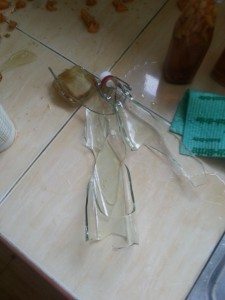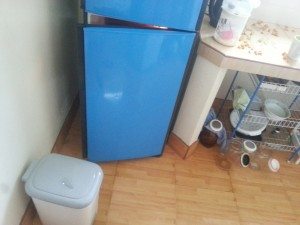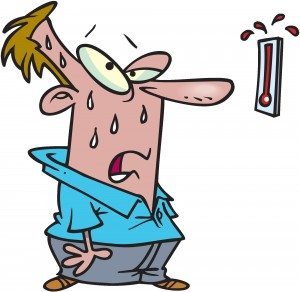How to Prevent Your Kombucha Bottles from Exploding

One warning you may read about (or hear via word of mouth) if you start making Kombucha second ferments is that you need to ‘burp’ your Kombucha containers every day or two (by opening up the lid) otherwise you risk the bottle exploding.
Now, even though I have a website about making Kombucha, in the years I’ve been brewing Kombucha, I never had this happen and I thought it was a bit of a myth.
Until it actually happened that is. Here is what I found in my kitchen:
So yes, it very much is possible to have your fermenting Kombucha explode. The result was that my Kombucha bottle exploded, flinging glass, SCOBY, and kombucha across my kitchen in a 10 foot diameter. The explosion (I was in the other room), was actually quite loud, sounding a bit like a dull firecracker.
Had I been in the room and within a few feet of the explosion, there would be chance of injury from the flying glass — likely minor cuts. If the glass shards hit the eye, however, the injuries would not be so minor.
Here’s a look at some of the evidence of the exploding bottle and the mayhem it caused in my little kitchen:
So if you don’t want to find yourself facing a similar situation, here’s how you can prevent such an explosion from happening to you, too.
I have taken my own advice here and since the explosion, have had no further repeats of this!
How to Prevent Komucha Bottles from Exploding During the Second Ferment
The first thing you need to understand is that the explosion is caused by the buildup of gas (cO2) byproduct when the yeast eats the sugar in an anaerobic environment (i.e. when the bottle is sealed preventing O2 from entering it). Too much pressure buildup by the gas and the structural integrity of the glass may be compromised and explode.
1. Burp the sealed kombucha container once a day (twice if you can)
Of all these tips, this is the most important and, likely, the only one you need to really follow exactly.
Burping your kombucha — that is, opening up the lid / latch to release the gas buildup — will prevent any sort of explosion from ever happening, guaranteed.
A full day of gas buildup will NOT exert enough pressure inside your container to explode it. Depending how warm it is in the room and how much sugar is in your kombucha, the yeast activity will vary between a little to a lot. But even if your yeast is highly active (eating the sugar), a single day won’t be enough to cause a problem.
You may be even to go two, three, four days or more without burping your brew. However, to avoid ANY problems, open your Kombucha once a day — or at most every two days — and release the gas buildup. This will, absolutely, stop any risk of an explosion from happening.
2. Use Quality Glass Bottles for the Second Fermentation
One of the reasons I had an explosion was because I did not use a quality glass container for my second ferment. I had a generic EZ Cap style bottle, but it was made in Thailand, bought from the local market here. As such, I have serious doubts about the quality and construction of the glass. Simply put, it’s not very strong. If you invest in some quality glass from a reputable company, you likely won’t have a problem with exploding kombucha bottles, even if you forget to burp the brew every few days. So don’t go cheap here on the bottles. You don’t have to spend a fortune on expensive glass, just buy your glass containers from a reputable, well known company that has a reputation for quality — this means they likely apply safety standard testing to their products.
These EZ Cap Bottles on amazon are recommended and good quality. Note though, even if you have good quality glass, you STILL can get an explosion if there’s enough pressure. Good glass quality simply reduces — but does not completely eliminate — the risk of an explosion.
Also remember, not all bottles equally trap CO2. The EZ Cap type bottles completely lock in all gas and do not allow the CO2 to release. If you use a canning style bottle, these are designed to allow some gas to escape. The bottles that completely seal in the gases often give you a more powerful fizz and better second ferment, but you run more of a risk of the bottles exploding. The caning styles jars do allow CO2 to escape, which means you may not have to burb the bottle at all, but you get a far less fizzy kombucha at the end of the second ferment.
3. Avoid Placing Your Container In Locations That Are Too Warm
The ideal temperature for brewing Kombucha is between 75 to 78 degrees. At this temperature, there is an ideal amount of heat that keeps the yeast and bacteria in perfect balance. Go too much above this temperature — or below it — and that balance is destroyed.
If the brewing temperature (read room temperature you place your kombucha in) is too warm, the yeast becomes TOO active and starts eating the sugar too fast and producing a lot of C02. While this does add a lot of extra fizz to your kombucha, it can also throw off the delicate taste of your Kombucha. It also means that you get a lot more CO2 pressure buildup in your container, increasing the risk that the container will explode if you do not burp it. Again, there are other factors such as the amount of sugar in your brew and the health of your SCOBY, but in general, warmer temperatures mean more CO2 buildup. Some CO2 adds a lot of texture to your second ferment. Too much, however, means your yeast is out of balance and your drink may not taste very good. It also means that if you do not burp your brew regularly, you could have an exploding bottle happen.
4. Don’t Add Too Much Sugar to the Second Ferment
Yeast is responsible for the production of CO2. And yeast feeds on the sugars in your Kombucha. During the second ferment you usually add extra ingredients to the brew to add more flavor (and fizz). Those ingredients usually include extra sugar in the form of fruit — either fresh fruit, fruit juice, or other ingredients which contain sugar.
That extra sugar is good — it adds more fuel to the mix which means the yeast will ramp up their activity and produce more CO2. This adds that nice fizz. But if you add TOO much sugar, the yeast may reproduce too quickly and build up too much CO2.
Again, this can be managed by burping the container regularly, keeping the temperature in the ideal range (75-77), using quality glass bottles. But it’s a factor that you need to consider. You don’t want to have too much sugar. In general, we recommend adding about 1-2 fresh cups of fruit (or 1 cup of fruit juice) for every half gallon of Kombucha (in cups about a 2/16 ratio of fruit to kombucha). You can obviously play with this formula too taste, but you don’t want to have something like 50 percent fruit juice and 50 percent kombucha.
5. Keep at least 1 to 2 inches Space at the Top of the Bottle
The space between the top of the liquid and the lid is the area that ‘stores’ the excess CO2 buildup. If you allow NO space at all to hold the gas, the pressure exerted on the bottle surface will be much more, sooner. This is why you don’t want to completely fill your kombucha bottle to the brim for the second ferment. Leave no space and the pressure buildup will be much quicker — this leaves you LESS leeway for time if you forget to burp your kombucha
I personally find that leaving 1 to 2 inches between the top of the liquid and the top of the lid works best — you get a strong CO2 buildup quickly, but you don’t run as much risk of the bottle exploding as if you leave no room at all.
One reason why the narrow EZ Cap bottles give a great second ferment is that you can fill up the bottle very high which leaves very little room for the gas buildup to occur. If you use a very wide-lidded jar, there is more room for the gas to build up in which takes longer, and you don’t get as potent a fizz.
So like most of these points here, there is a balance you need to find. This may not sound like a big deal, but it does dramatically impact how fast your CO2 builds up in your second ferment and how much fizz you end up with. SO make sure you do leave a couple inches of space to reduce the chance of an explosion.
6. Don’t Second Ferment for Too Long (unless it’s cooler weather)
Letting your second ferment last for long periods may increase the flavor but it also increases the risk of a bottle explosion, especially if you don’t burp the bottles. I find that once you start getting fizz after the first or second day, the fizz builds up faster and faster.
It’s possible to let your ferment sit for long periods (days..even weeks), with no explosion. However, the more pressure there is in the bottles, the more likely you’ll have the kombucha explode out and making a mess everywhere.
If you want to ferment for days or weeks, only do so if the weather is cool (55-65 degrees) which slows down the fermentation process. if you are brewing at 70+ degrees (especially if it’s 78+), you might get an explosion if you let your bottles sit around for more than a couple days without burping them.
7. Put your bottle in the fridge for a day or two before opening
One way to reduce the pressure inside of the bottle (that I’ve found) is to refrigerate the bottle for a day (or two). This seems to reduce some of the pressure. I can’t guarantee it will work for you, but it’s worked for me. I find this trick helps prevent fizz explosions when opening the bottle.
8. Put Your Bottles in a Cardboard Box with the top closed
This tip comes from one of the readers!
If you’ve ever had an explosion, you’ll know what a mess it can make. Glass shards everywhere (10 to 15 feet even) with kombucha soaking into the surrounding area. One way to minimize the damage, should an explosion happen, is to put the second fermenting bottles into a box and cover it up. If the explosion happens, glass won’t go flying everywhere and the mess will stay in the box. It’s also prevents possible glass from hitting you. Of course, you don’t get to see the lovely fermentation, but if you are terrified of an explosion, this strategy is something to consider.
The Final Word
I hope this article helps you prevent your kombucha bottle from exploding during the second ferment.
Note that you won’t ever have a problem with exploding Kombucha bottles during the initial kombucha brew (the first ferment) because your Kombucha is unsealed, hence there is no pressure build up.
If you follow the five tips given above to prevent exploding kombucha, you won’t ever have an explosion. By far, the most important tip is the first one: burp your kombucha every single day. This will completely prevent an explosion, unless you are very, very unlucky.
If any of you have had an exploding kombucha situation, please let me know in the comments!














